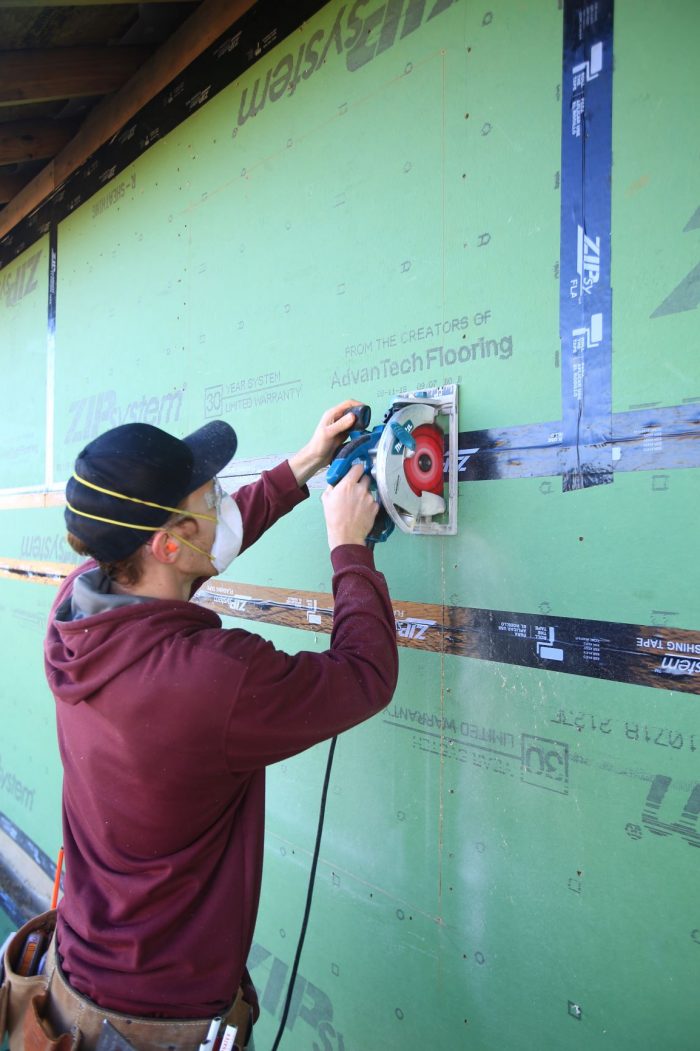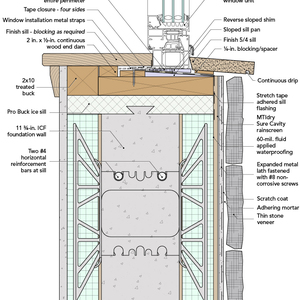
Some of you may have taken the time to watch my video series with Fine Homebuilding about properly installing flanged windows in multiple assemblies. Those methods apply to most windows installed in the USA. However, they don’t apply to flangeless or “European style” windows, including the triple-glazed, tilt/turn windows preferred by many high-performance builders.
Of course, some of the fundamental principles are the same, shingle-style lapping for example, is the only way to detail any window flashing, as well as using a back dam and creating a slope at the sill of the rough opening. In this article I will share how we are installing flangeless windows in the wall assembly that we utilize most commonly. On the project shown here the windows are from Schuco, though many European-style windows install similarly. I would refer to this install as a face-sealed system.
Locating the window in the opening
Over the past five years we have not built a home with a finished wall thickness less than 7 ½ inches. Most likely on our builds that includes 2×6 framing (5 ½ inches) plus ½ inch drywall inside and 1 ½ inch ZIP R-sheathing outside. Warming the wall with the insulated sheathing has become a standard detail in our homes. Having this thick wall gives us an opportunity to make choices about how our Euro-style, flangeless windows are installed.

The window could be pushed outward in the assembly. Like a flanged window, this presents more challenges for water management because the window is closer to the weather. Moving the unit to the interior face of the wall better protects the unit from the elements, but in doing so, also moves the unit away from the sunlight…
Weekly Newsletter
Get building science and energy efficiency advice, plus special offers, in your inbox.

This article is only available to GBA Prime Members
Sign up for a free trial and get instant access to this article as well as GBA’s complete library of premium articles and construction details.
Start Free TrialAlready a member? Log in















17 Comments
Jake, this is a great resource- Thank You!
Thank you Rick!
The whole series is excellent.
There's a YouTube video from Hammer and Hand covering the same install process with some alternative tweaks to what Jake's outlined above. Karuna PH Window Install Demo: https://youtu.be/mmUJQHN7ALw
One of the favorite things about our house is the innie, or technically "in-between", center of wall assembly placement of our windows. It provides a substantial sill area both on the interior and the exterior, and it nicely accentuates the thickness of the overall wall assembly. On the exterior it also provides some nice shadow lines on the facade throughout the day, particularly on the south side, which sees a lot of sun.
We used Hannoband expanding black foam tape around our windows and doors and were extremely pleased with how it performs (it's available from Small Planet Supply). This could be an alternative to spray can foam, or the Tremco product noted in the video.
For our basement windows I applied Prosoco Air Dam sealant on the interior of the window frames as a final air barrier. For the rest of our windows I used Profil tape from 475HPBS. The Profil tape has a split backing that makes using it very easy. It has a cloth-like face and is easy to cut with a razor blade as you move around the window frame setting strips of tape.
Excellent summary, Jake!
Thanks Jake. I can refer builders who haven't done this before to this article and save a lot of effort. I'm glad you pointed out that setting the window in a bit from the outside creates a little roof. I view this as simplifying the flashing. The head flashing now has a much simpler job to do in effect.
Thank you for the write-up. I am installing European Windows on a new construction for the first time. The window will sit in the middle third of the wall, similar to above. Can you recommend the canned spray foam used?
Do you have any instructions on how to install a Lift and Slide slider?
I do not have any instructions yet. How about the next time I install one, Ill take the time to create a best practice manual?
Jake,
Thank you for adding this to your window installation series. I have watched them all more than once in an effort to further perfect my window installs. I have been trying to find a good source for flangeless windows and have found a few (including that Hammer & Hand video).
I am have a small remodeling/construction business in northern NY, and I am awaiting delivery of a container of Zola flangeless windows for my personal home (about 40+ windows and 2 lift-slides). I have been back and forth about mounting them flush to the outside or setting them back in. I will be doing a 3/4" rainscreen with Zip-R on the basement and with the main story being SIP walls. That is the final detail I have to decide on: how far to recess, or not. I am trying to keep things simple and easy to keep water out, but want it to look nice and last a lifetime.
Any recommendations on incorporating with a rainscreen that will have 1x8" western red cedar clapboards? My RO's are 1" larger than the window width, and 1 3/8" larger than the window height (planning 5/4" interior sills with trimless sides & top). Thank you again for sharing this article, looking forward to seeing more as you bring it to the community.
Nick Bertrand
Nick,
Thanks for the feed back. My suggestion is to place the windows in the middle 1/3 of the wall thickness. By placing the window in the middle you limit the chances of creating a microclimate on either side of the window. By shifting the window inward we better protect the head of the window as well, which is where most leaks take place.
Jake Bruton
Jake,
Thanks for the reply. Do you have any articles or know of any articles/videos detailing the finishing of the outside of an inset window install? I'm wondering if it is best practice to make custom aluminum pans for the bottom/sides/top? Or maybe just the bottom and regular trim on the sides?
Thank you again!
Nick
Nick, you can check out photos and info detailing our 'innie' windows here:
https://kimchiandkraut.net/2019/07/11/siding-1-of-2-continuous-insulation-with-a-rainscreen/
https://kimchiandkraut.net/2019/09/21/siding-part-2-charred-cedar-shou-sugi-ban/
Even if you decide to change some of the details, I find it's helpful to see how others do things before finalizing design details.
Most of what we did was based on Hammer and Hand YouTube videos, along with their Best Practices Manual ( https://hammerandhand.com/best-practices/manual/ ).
Also, if you google search 'passive house windows exterior finish' photos and links to articles, some of which have appeared here on GBA, show the variety of ways to finish 'innie' windows.
Good luck with your project!
Eric,
Thank you for the links and the reply. I've actually followed the Urban rustic project off and on for a bit; I will review things more closely. I have the H&H manual bookmarked and like to reference it from time to time to verify details. It's always better to see pictures and diagrams when it comes to the more and more complicated detailing that occurs as we increase the science involved with getting buildings to be healthy, long-lasting, and efficient.
Nick
I disagree with the approach to seal the sill. There is no need to do this and you haven't given any reasons I can see to necessitate face-sealing.
1. Not all flangless windows are set back in the wall
2. Even if they are set back, this 3" +/- overhang is hardly worth mentioning. The rain is still hitting those windows with even a small wind
3. As with any other window, worry about the air sealing on the interior, not the exterior where you need the drainage
4. The tape is vapor open, which maybe helps let some water migrate out slowly if it's sitting in the pan? But it also seems like a poor choice on the top and sides where you are definitively trying to keep water out.
Euro style windows can be effectively installed with either a folded tape as you show or a commercial grade sealant over backer rod. Whatever approach you choose, there is no reason to change the fundamental strategy of letting the water drain out of the pan and onto the water control layer. This requires leaving the sill open or using weep holes. Seal the back side of the pan, hopefully slope the sill etc.- do the normal things to direct water out, not trap it in.
The window unit you show also has weep holes already, which may help mitigate your risk. Some of those windows are basically already a window inside a pan with it's own weep holes; it depends on the construction of the unit. If the lower "pan," or frame, is well constructed the risk is probably very low if you face seal it, but not all euro-style windows are made like that.
I'm confused that FHB and GBA sent this to print. Even on the education side of the industry people can't seem to agree on a robust "drainage approach" to window installation and water management. It's not therefor surprising that there is so much confusion out there and so many leaks.
"As with any other window, worry about the air sealing on the interior, not the exterior where you need the drainage": this is the way to go 👍🏻
I agree, this seems to be confusing considering so many others seems to indicate the necessity of having the bottom open to drainage plane. Just ordered windows from Inline Fiberglass and their (very old looking) install recommendations also highlights the bottom drainage plane (for flangeless install). Inline recommends a flashing to be installed to bottom of window and over the shims though, which I find a bit tough to put into practice for most crews...
How about weep holes in the bottom tape as a go-between option?
If you're mounting the flangeless window flush with sheathing, do you still need the backdam? Would the window just set on the sloped sill (from the beveled siding) flashed into the sill pan of the rough opening?
Brian,
Folding up the sill membrane at the back of the window frame is a good and easy back-dam.
Log in or become a member to post a comment.
Sign up Log in